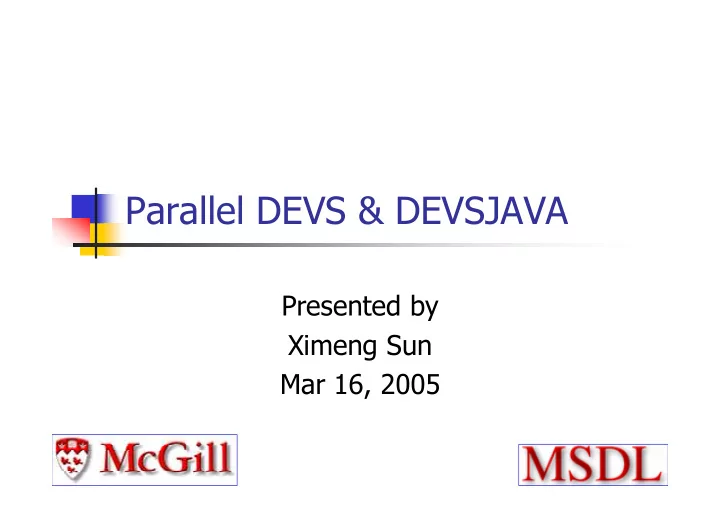

Parallel DEVS & DEVSJAVA Presented by Ximeng Sun Mar 16, 2005
References � Bernard P. Zergler, Herbert Praehofer, and Tag Gon Kim. Theory of Modeling and Simulation. Academic Press, 2000. � Bernard P. Zergler, Hessam S. Sarjoughian. Introduction to DEVS Modeling and Simulation with JAVA. http://www.acims.arizona.edu/SOFTWARE/software .shtml#DEVSJAVA
Outline � Classic DEVS quick review � Why Parallel DEVS � Parallel DEVS Formalism � Atomic Model � Coupled Model � Closure under Coupling � Parallel DEVS Simulation Protocol � DEVSJAVA
� Classic DEVS quick review � Why Parallel DEVS � Parallel DEVS Formalism � Atomic Model � Coupled Model � Closure under Coupling � Parallel DEVS Simulation Protocol � DEVSJAVA
Classic DEVS formalism
DEVS in action
Classic DEVS Coupled Model � . � . � D : the set of the components names. � M d : component DEVS models � EIC : external input coupling connects external inputs to component inputs � EOC : external output coupling connects component outputs to external outputs � IC : internal coupling connects component outputs to component inputs � .
� Classic DEVS quick review � Why Parallel DEVS � Parallel DEVS Formalism � Atomic Model � Coupled Model � Closure under Coupling � Parallel DEVS Simulation Protocol � DEVSJAVA
Simple Pipeline model
In Action
Simultaneous events Q? For p1 which one is correct: δ int –> δ ext or δ ext –> δ int
Indirect control � In Classic DEVS, only one would be chosen to execute by Select function. � Select: s – > p1 ≡ internal-transition-first � Select: s – > p0 ≡ external-transition-first
If there ’ s a feedback …
Lose input anyway � In Classic DEVS, always make the same choice among imminent components. � Select: s – > p0|p1 ≡ p0|p1 loses input
� Classic DEVS quick review � Why Parallel DEVS � Parallel DEVS Formalism � Atomic Model � Coupled Model � Closure under Coupling � Parallel DEVS Simulation Protocol � DEVSJAVA
Parallel DEVS Atomic Model X b is a set of bags over elements in X .
Extensions of Classic DEVS � Allowing bags of inputs to the external function � Inputs may arrive in any order � Inputs with the same identity may arrive from one or more sources � Introducing confluent transition function � Localize collision tie-breaking control
Confluent Transition Function � Collision: e = ta(s) � Classic DEVS: by Select function, at coupled model level – Global decision � Parallel DEVS: by , to each individual component – Local decision � Default: δ con (s,x) = δ ext ( δ int (s),0,x) � Or: δ con (s,x) = δ int ( δ ext (s,ta(s),x))
Parallel DEVS Coupled Model � . � Identical to Classic DEVS, except for the absence of the Select function � X : a set of input events � Y : a set of output events � D : a set of component references � M d : a Parallel DEVS model, for each � I d : a set of influencers of d , for each � Z i,d : a set of output-to-input translation functions, for each
Previous example
Handling of imminent components in Parallel DEVS
Problem in Classic DEVS solved
Closure under Coupling of Parallel DEVS � Resultant of the coupled model: � Partition components into 4 sets: . imminent components . components about to receive inputs (confluent components) � (imminent components � receiving no input) (components receiving input � but not imminent) . (remaining components) �
Closure under Coupling of Parallel DEVS � Functions of the Resultant: � Output Function: � Internal Transition Function:
Closure under Coupling of Parallel DEVS � External Transition Function:
� Confluent Transition Function:
Generic Transition Function Component is ? Recipient only: Confluent: Imminent only:
� Classic DEVS quick review � Why Parallel DEVS � Parallel DEVS Formalism � Atomic Model � Coupled Model � Closure under Coupling � Parallel DEVS Simulation Protocol � DEVSJAVA
Hierarchical Model Coupled Model coordinator simulator Atomic Model Coupled Model coordinator simulator simulator Atomic Model Atomic Model
Atomic Model Simulator
Coupled Model Simulator
� Classic DEVS quick review � Why Parallel DEVS � Parallel DEVS Formalism � Atomic Model � Coupled Model � Closure under Coupling � Parallel DEVS Simulation Protocol � DEVSJAVA
DEVSJAVA � DEVS-based, Object-Oriented Modeling and Simulation environment. � Written in Java and supports parallel execution on a uni-processor � Simulation Viewer for animating simulation in V2.7
Package Diagram
DEVSJAVA Class hierarchy of container classes
DEVSJAVA Class hierarchy of DEVS classes
Simple Pipeline in DEVSJAVA
Simulation Viewer
More complicated example
Sources � DEVSJAVA - Modeling and Simulation environment for developing DEVS-based models by Hessam Sarjoughian, Bernard Zeigler. � http://www.acims.arizona.edu/SOFTWARE/software.s html#DEVSJAVA (need a license)
Question?
Recommend
More recommend